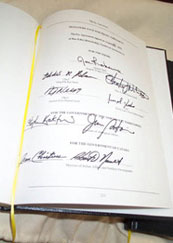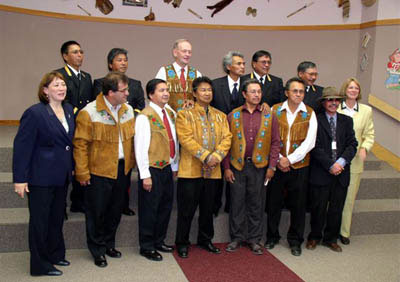Chronology of the Tłı̨chǫ Negotiation Process
- 1921 - Monfwi signs Treaty 11
Monfwi signed Treaty 11 with the Government of Canada on August 22, 1921, on behalf of all the Dogrib of the North Slave. The Treaty promised to give the Tłı̨chǫ annual payments and services, like medical care, education and old age care. In exchange, Canada would get title to the land, and would be free to allow gas and mineral exploration throughout the Mackenzie Valley. Treaty 11 was negotiated during the summer of 1921. During the negotiations, many concerns were raised, but Canada assured the people that they would not lose their right to hunt, fish and trap. By the end of the summer, Chief Monfwi signed the Treaty at a ceremony in Behchokǫ̀. At the time of signing, Chief Monfwi pronounced the words that guide us to this day: “as long as the sun rises, the river flows, and the land does not move, we will not be restricted from our way of life”.
- 1976/1977 - Canada accepted comprehensive land claims for the Dene and Metis in the Northwest Territories.
This was largely because land entitlement under Treaties 8 and 11 were virtually unfulfilled and it was also to maintain consistency of treatment among northern Aboriginal peoples. Joint Dene and Metis land claim negotiations began in 1981.
- 1988 - A Dene/Metis Agreement-in-Principle (AIP)
AIP was signed in September 1988. A final agreement was initialed on April 9, 1990.
- 1990 - the Dene/Metis Final Agreement was rejected by the Dene/Metis
Due to the proposed certainty (surrender) provisions and the lack of self-government provisions. The Gwich’in disagreed with this action and requested a regional settlement. Canada announced it would negotiate regional claims on the bases if the 1990 agreement. The Gwich’in and Sahtu Dene and Metis finalized their comprehensive land claims settlements in 1992 and 1994 respectively.
- 1992 - the Dogrib (Tłı̨chǫ) submitted a regional claim in the fall of 1992.
The First Assembly of the Dogrib Treaty 11 Council gathered on August 24-28, 1992. Delegates unanimously passed a resolution mandating the Dogrib Treaty 11 Council to “assume full control and responsibility for negotiation” for a Dogrib Nation Regional comprehensive Claim. The Dogrib (Tłı̨chǫ) submitted a regional claim in the fall of 1992.
- 1994 - Negotiations began with the Dogrib in the North Slave region on a North Slave Agreement
However, Treaty 8 Dene in two communities near Yellowknife chose to align with other Treaty 8 Dene and not to participate in the Dogrib negotiations. This led to an overlap/boundary issue between Treaty 11 Dogrib and the Treaty 8 Dene.
- 1995 November - the Minister of DIAND agreed to a pause in Dogrib negotiations
While a new Chief Federal Negotiator was appointed and discussions were held to explore interests and to determine the impact of the anticipated inherent right policy on the Dogrib land claim. Released in August 1995, it was apparent that the new self-government policy would have a profound effect on land claim negotiations. It was determined that a new mandate was necessary - one that combined self-government and land claim elements.
- 1997 - The new federal mandate was received in April 1997.
The previous mandate to negotiate a comprehensive land claims agreement (only) was replaced by a mandate to negotiate a joint land claims and self-government agreement with the Dogrib Treaty 11 Council.
- 1999 - The Dogrib First Nation considered the Dogrib Agreement-in-Principle (AIP) for approval.
- 2000 - The Dogrib accepted the AIP on January 7, 2000.
In July 2000, the Government of Canada announced the withdrawal of approximately 39,400 square kilometers of land, pursuant to the land identification process outlined in the Dogrib AIP. An extensive public consultation followed. Within this land withdrawal area, a block of land was later identified to become “Dogrib Lands” when the Dogrib Agreement comes into effect.
- 2002 - The Dogrib decided that they preferred to use the word “Tłı̨chǫ”
Which means Dogrib in their language, to identify themselves and for the title of the Agreement. The Chief Negotiators initialed a “Tłı̨chǫ Agreement” on September 4, 2002. Rather than immediately start the ratification process, however, the Chief Negotiators decided to open the Tłı̨chǫ Agreement for public comment and feedback. An information exchange period followed. Chief Negotiators met with Aboriginal groups, interest groups and the general public to gain feedback on the Tłı̨chǫ Agreement. During the information exchange period, overlap discussions between the Tłı̨chǫ and the Deh Cho and between the Tłı̨chǫ and the Akaitcho (Treaty 8 Dene) gained momentum. The Tłı̨chǫ (Dogrib Treaty 11 Council) reached historic overlap agreements with both of these groups in the fall of 2002.
- 2003 March - Tłı̨chǫ Revised Agreement
 | The Tłı̨chǫ Agreement was revised as a result of these overlap agreements and the feedback and comments that were received during the information exchange period. The revised Tłįchǫ Agreement was then initialed by the Chief Negotiators in March 2003, which formally started the ratification process for the Tłįchǫ Agreement. |
- 2003 June 26 & 27 - Vote of the Tłı̨chǫ Land Claims and Self-Government Agreement
Eligible voters voted in favour of the Tłı̨chǫ Agreement on June 26 and 27, 2003. A total of 93% of eligible voters participated in the vote and 84% of eligible voters were in favour of the Tłı̨chǫ Agreement.
- 2003 August 25 - Tłı̨chǫ Land Claims and Self-Government Agreement Signed
The historic Tłı̨chǫ Land Claims and Self-Government Agreement was signed in Behchokǫ̀ on August 25, 2003, exactly 82 years after Chief Monfwi signed Treaty 11. Prime Minister Jean Chrétien and many other dignitaries were on hand for the official signing of the Agreement. "What we see today is that in spite of the evolution of society, you have kept your culture and pride," said Chrétien. "This is the glory of Canada – we can be what we are and at the same time be part of the greater Canada." After the signing, and the mark the beginning of the celebration, Grand Chief Joe Rabesca and Elder Alexis Arrowmaker each took an arm of the Prime Minister and led him in the historic tea dance. The photo capturing this moment appeared in newspapers around the world.

- 2003 September 23 - Signed by all three parties to the Tłı̨chǫ Land Claims and Self-Government Agreement.
- 2004 June 27 - Tłı̨chǫ voters supported the Ratification vote with an overwhelming 92.7%.
The results were announced to a packed auditorium at the Cultural Centre in Behchokǫ̀ and led to a celebration of traditional singing and dancing by everyone present.
"In 1921, our great Chief Monfwi, entered into a relationship with the Government of Canada, called Treaty 11," said Grand Chief Rabesca. "Today, our people have continued the work begun by our great Chief Monfwi by approving this Agreement. I'm overwhelmed by the support of our people, for the work of our negotiators and cannot begin to express what a proud day this is for the Tłı̨chǫ," said Rabesca.

- 2005 February 15 - Royal Assent of the Tłı̨chǫ Land Claims and Self-Government Agreement
The Government of Canada Act received Royal Assent February 15, 2005. This is the legislation approving the first comprehensive land claim and self government agreement in the Northwest Territories and the second such agreement in Canada.
- 2005 August 4 - Tłı̨chǫ Land Claims and Self-Government Agreement
Comes into effect and with it, the Tłı̨chǫ Government is established. It was an historic day for the Tłı̨chǫ. Tłı̨chǫ Government owns, manages and controls over 39,000 square kilometers of lands in the Northwest Territories. Under the Tłı̨chǫ Constitution, we acknowledge our responsibility to serve for all time as custodians of these lands, as Monfwi said, “for as long as this land shall last”.
Milestones
- 2015. August 4 - 10 years now since the Tłı̨chǫ Agreement.
Grand Chief Eddie Erasmus spoke on August 6, 2015 on behalf of the Chiefs Executive Council, Chief Clifford Daniels, Chief Alfonz Nitsiza, Chief David Wedawin and Chief Johnny Arrowmaker, and the Assembly members of the Tłı̨chǫ Government, remembering a decade of challenges, and successes. Today, we celebrate together and share in the social, political and cultural activities of the Tłı̨chǫ.
“It has been a long journey to where we are today as a self-governing Tłı̨chǫ Nation. As Tłı̨chǫ, we made a decision in 1992 at our ‘First Assembly’ to pursue a Land Claim and Self-Government agreement with governments, so that their laws and systems would recognize our structure of government, land ownership and our law making authority.”
Visit Tłı̨chǫ History Website for more information on the Tłı̨chǫ.


